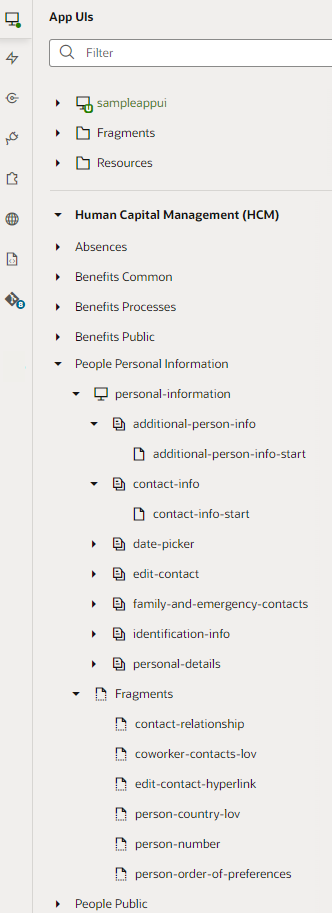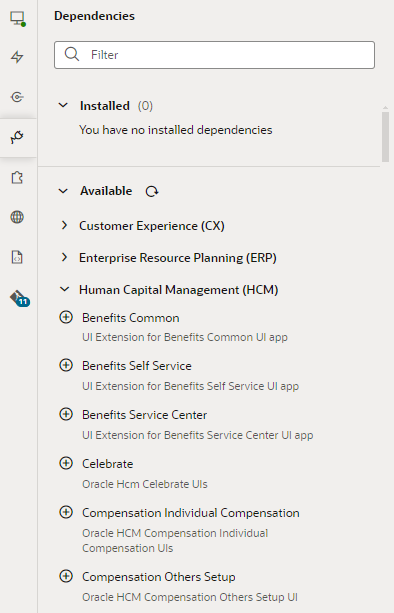What Are Dependencies?
When an extension is listed as a dependency, it means you have access to all its resources—like service connections or Layouts—which you can then reference while building your own App UI. It also means you can configure (customize) the extension's App UIs to better suit your business needs.
Extensions are listed by pillar in the Designer's Navigator, under a separate section in the App UIs pane. At a minimum, you'll see the Unified Application listed here, as it is considered a dependency for everything in the Oracle Cloud Applications ecosystem. Depending on how you came to Visual Builder Studio, you may see other extensions listed here as well. For example, here's what you may see when you're working on an extension that belongs to the Human Capital Management pillar: 
Description of the illustration dependnames.png
Let's take a closer look at this example: When you're editing the contact-info-start page in the HCM pillar, the Person Information extension that's directly associated with your page is listed as a dependent extension under Human Capital Management in the App UIs pane. This means that you can now open the extension/App UI and tweak any of its pages with extendable artifacts, such as dynamic tables or forms, dynamic containers, variables, and so on. You can also use the fragments in the extension's Fragments folder in your own App UIs. If a fragment in this folder has at least one artifact marked as extendable, you can additionally customize the fragment for your own use.
In addition to the Person Information extension, several other extensions—such as Absences, Benefits Common, and Benefits Public—are also listed. That's because all extensions in the same pillar as your dependent extension become available for you to explore. So even though your extension might only depend on resources in Person Information, you can explore all extensions in the HCM pillar to locate resources you might want to add to your extension without actually adding them to your extension.
So when might you see an extension listed on the App UIs pane? If you jumped over from Oracle Cloud Applications by clicking Edit Page in Visual Builder Studio, VB Studio shows the extension associated with the page you were just viewing, along with all other extensions in the same pillar. (The exception here is when you're working with extensions belonging to the CX and Other pillars, where only the extension directly associated with your page is shown. If the extension for the CX page you're editing defines a more granular grouping via the Extension Pillar Subcategory setting, all extensions within that subcategory are shown.)
If you created a workspace by selecting New Application Extension on the Workspaces page, you're essentially creating an empty extension, which is what you use to create a new App UI or to extend the Unified Application. In this case, you'll only see the Unified Application. Once you add an extension as a dependency, all extensions in that pillar will be listed under the pillar's name.
To add a dependency for your extension, use the Dependencies pane, where all available dependencies are listed by pillar for easier identification:
Description of the illustration listofdependencies.png
Keep in mind that you add the extension containing the App UI as a dependency, not the App UI itself.
Simply put, you add an extension as a dependency when you want to configure an App UI (that is, make changes to it) in the extension, or access the resources in the extension (like service connections or Layouts, which you'll find listed by pillar on the Services and Layouts pane) while building your own App UI.
Note:
If you’re building your own App UI and want to make it available to others to configure, you must be sure that the App UI includes at least one extendable artifact—a variable, a dynamic component, or something else marked Available to extensions. If it doesn’t, the extension won’t appear in the Dependencies pane.The Unified Application provides global services and a common user interface shell to all of the App UIs that plug into it, whether created by Oracle or developed at your enterprise. For this reason, it's considered a dependency for everything in the Oracle Cloud Applications ecosystem. You don’t have to worry about this underpinning, but you should know that it, too, is configurable; all you have to do is open the Unified Application and modify it, just as you would any other App UI. Note that the ask-oracle-bo-metadata and ask-oracle-chat fragments, while globally available to all App UIs in your extension, are internal to the Unified Application and cannot be customized or referenced in your extension.